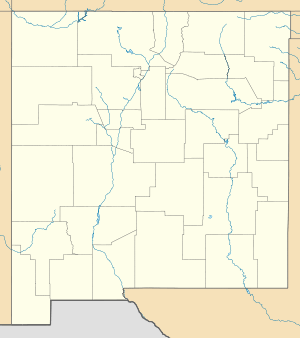Sandia Cave
|
Sandia Cave | |
|
View from inside the cave. | |
  | |
| Nearest city | Bernalillo, New Mexico |
|---|---|
| Coordinates | 35°15′18″N 106°24′22″W / 35.255°N 106.406°WCoordinates: 35°15′18″N 106°24′22″W / 35.255°N 106.406°W |
| NRHP Reference # | 66000487 |
| Significant dates | |
| Added to NRHP | October 15, 1966[1] |
| Designated NHL | January 20, 1961[2] |
Sandia Cave is an archaeological site near Bernalillo, New Mexico, within Cibola National Forest, that is open to the public. It is rather difficult to reach, as it is located high up on the steep wall of Las Huertas Canyon on the north end of the Sandia Mountains.[3]
A statement of its significance in 1961 read:
Excavations here have yielded information on three distinct prehistoric groups. Situated in Cibola National Forest, the site represents one of the earliest known occupations of the Americas.[2]
A recent condition report is:
Sandia Cave appears to be in satisfactory condition. This natural cave is located in a limestone cliff face above Los Huertas Creek in the Sandia Mountains. The cave was prehistorically occupied and has been intensively excavated. The site is publicly accessible via a quarter-mile trail and a metal circular staircase leading to the cave entrance. The length of the cave is unknown and the inspection was performed on the first ten meters of the interior; after this point the cave narrows and artificial lighting is necessary. This site is not at risk from environmental or natural causes. Since the site has been thoroughly excavated, there are no portable artifacts, walls, or fragile components that need to be protected. The greatest threat to this site is the potential for vandalism. The site has experienced heavy vandalism over the past several years. The entrance to the cave is covered in graffiti done primarily with spray paint but markers, chalk, crayons, and etching have also been used. The graffiti also appears on the bars and railings that support the staircase and cage-like entry way. More graffiti is present within the cave but is slightly less dense than at the cave entrance. The ceiling of the cave is covered with a heavy layer of soot from prehistoric occupation and graffiti has been applied to many parts of the soot.There does not appear to be a significant amount of new graffiti within the cave since the last report, although some of the more recent graffiti (possibly within the last year) covers a large area. There are no other changes to the site itself since the last report.[2]
It was declared a National Historic Landmark in 1961.[2][4]
History
Archaeologists argued about claims associated with this site for decades, making it difficult to determine its importance.[5] The site was excavated in the 1930s and 1940s by Frank Hibben while at the University of New Mexico[6][7]
Both Folsom and Sandia hunting points were recovered, with the hitherto unknown Sandia points interpreted by Hibben as being much older than any other evidence of man in North America. Faunal remains included extinct, Pleistocene mammals.[7] Later study of stratigraphy and radiometric dates corrected serious earlier misinterpretations, leaving "Sandia Man" as definitely younger than earlier claimed.[8]
Faunal remains recovered by Hibben and others include such extinct forms as mammoth, mastodon, sloth, horses, and camels, as well as many mammal and bird species that survived the end of the Pleistocene, making this one of the most important Pleistocene paleontological sites in northern New Mexico.[9]
External links
- Video of two spelunkers exploring Sandia Man Cave
- Description of Sandi Cave at showcaves.com
- Sandia Cave listing at USFS Cibola National Forest web site
References
- ↑ National Park Service (2008-04-15). "National Register Information System". National Register of Historic Places. National Park Service.
- 1 2 3 4 "Sandia Cave". National Historic Landmark summary listing. National Park Service. Retrieved 2008-06-14.
- ↑ "Sandia Cave". Retrieved 4 April 2011.
- ↑ Note: A National Register of Historic Places Inventory-Nomination document should be available upon request from the National Park Service for this site, but it appears not to be available on-line from the NPS Focus search site.
- ↑ Preston, Douglas. 1995. The mystery of Sandia Cave. New Yorker 71:66-72.
- ↑ Hibben, F. C. 1937. Association of man with Pleistocene mammals in the Sandia Mountains, New Mexico. American Antiquity 2:260-263.
- 1 2 Hibben, F. C. 1941. Evidences of early occupation in Sandia Cave, New Mexico, and other sites in the Sandia-Manzano region. With appendix on correlation of the deposits of Sandia Cave, New Mexico, with the glacial chronology. Smithsonian Miscellaneous Collections 99(23).
- ↑ Haynes, C. V., Jr., and G. A. Agogino. 1986. Geochronology of Sandia Cave. Smithsonian Contributions to Anthropology 32:1-32.
- ↑ http://www.utep.edu/leb/pleistNM/sites/sandiacave.htm